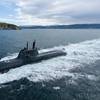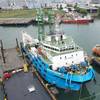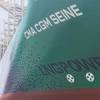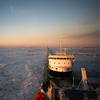Firefighting led a stream of topical debate at trade association Interferry’s 40th annual conference in Copenhagen last week – but not before a record 342 delegates came under fire from a leading Green politician claiming that ‘shipping is currently one of the unaddressed areas of air pollution’.
Michael Cramer, German chair of the European Parliament’s transport and tourism committee, delivered a stinging opening address demanding that the ferry and shipping sectors become more environmentally sustainable. He said ‘most vessels are like hazardous waste incinerators because they burn heavy fuel oil which should be processed as highly toxic waste but is usually exhaled without sufficient filtering’. He alleged that, according to recent studies, this caused 50,000 premature deaths per year in Europe at an annual cost to society of €58 billion.
Cramer conceded that the carbon footprint of a tonne of goods carried by ship was lower than any other transport mode. He also acknowledged that some shipowners had already acted to reduce emissions, but called for the industry to explore further technological and operational measures – a plea answered in several subsequent sessions devoted to innovation.
CEO bids farewell
In another conference highlight, Interferry CEO Len Roueche earned a standing ovation after disclosing his decision to retire next March. During his 14 years in the post, the association has won IMO consultative status, set up a dedicated IMO and European Union affairs office in Brussels, become a founder member of the new UN high level advisory committee on sustainable transport and grown membership to more than 200 companies in 35 countries. Roueche pointed to Asia and Africa as the next growth areas – next year’s conference will be in Manila – and urged continuing support for Interferry’s ‘voice of the industry’ role in helping to shape safety and environmental regulations.
Interferry chairman Mike Grainger, managing director of Liferaft Systems Australia, paid tribute to Roueche’s outstanding leadership and announced that Darrell Bryan, retired former president and CEO of Seattle-based fast ferry operator Victoria Clipper, will be Interferry’s interim CEO pending the appointment of a permanent successor.
Transport chair’s challenge: ‘must do better’
Michael Cramer illustrated his concerns over shipping’s ‘decisive role’ in air pollution with a string of statistics. He said that 70 percent of global maritime emissions came within 400km of coastlines, with vessels operating at EU ports accounting for up to 30 percent of worldwide CO2 shipping emissions.
Global shipping produced more than one billion tons of CO2 per year. This amounted to 3 percent of world greenhouse gas emissions and was expected to reach 6 percent by 2020 unless an ambitious framework was set at the highest level. “The IMO proves that significant steps are possible,” said Mr Cramer. “At the same time, the larger the forum is, the more difficult it gets to establish common standards.” Expressing ‘sincere regret’ that Europe did not emulate the US and Canada in establishing Emissions Control Areas legislation for the whole continent, he stressed: “Every next step we take has to be decided if not on a global then at least on a common European level…the sooner the better.”
He suggested that Europe could show the world what was possible, pointing out that a European Commission-inspired monitoring, reporting and verification system for CO2 emissions was set to come into force in 2018 for all ships over 5,000gt calling at EU ports, with an anticipated 2 percent per voyage emissions reduction.
Future improvements in environmental performance would depend on strong control mechanisms and a fundamental change of outlook on mobility – which Cramer summarized as moving from oil-based fuels to zero-emission renewables such as solar and wind power, allied with better route planning, distribution and capacity utilization. He said existing technologies could lower CO2 emissions by 75 percent while simply reducing speed by 10 percent could cut energy use by some 19 percent.
Remarking that ‘complaining is part of your trade’, Cramer argued that the industry’s regulatory worries had not been confirmed. In fact, as shown by the need to adapt to the sulphur rules, they had inspired ‘something in the shipping sector we have missed for many years – the spirit of innovation’. He said the EU was providing record financial support for smarter transport projects: €26 billion up to 2020 – including ‘a lot of money’ for shipping.
He concluded, “I see great potential in the shipping sector to contribute to changed mobility, especially in the ferry sector. We will do our best to encourage you further by supporting your innovative ideas on getting shipping more sustainable and promoting further integration to other transport modes.”
Interferry regulatory affairs director Johan Roos told delegates, “I think Mr. Cramer and his EU colleagues have their hearts in the right places but where we differ is how to get there. If fuel prices hadn’t dropped it would be a different picture right now. We have seen the EU’s political will to push on with its plans and we have to be ready for that.”
In a later statement he added, “We are working closely with EU officials to agree realistic solutions to our shared long-term aims on emissions. However, realism can be forgotten when our proposals go before the politicians. Their unpredictability is truly frightening because all too often decisions ignore the vast real-world cost implications for our industry. Companies could definitely go out of business and, ironically, a key element of the transport infrastructure would be dangerously weakened to the detriment of green goals.”
Regulations: ‘let’s talk’
The battleground over environmental regulations in northern Europe was mapped out in a panel debate representing owners and authorities.
Patrick Verhoven, secretary general of the European Community Shipowners’ Associations, complained that operators had invested in scrubber equipment in good faith only to find that another EU department was questioning whether it was allowed. He criticized the ‘eternal dilemma’ about the EU wanting to add another level to international regulations with ‘little appreciation of what is going on at the IMO’. He went on: “We need to explain much better the good work being done there and take away the distrust among members of the European Parliament.” Politicians had forgotten that shortsea shipping was meant to be an alternative to road transport – it was a mode that could help in the sustainability story but there was ‘definitely not a level playing field’.
DFDS sustainability director Poul Woodall asked: “Is it fair that we are saving 300,000 tonnes of sulphur emissions in Europe but it’s costing 30 million tonnes of CO2 instead? And how many noninvasive species are we going to kill under the ballast water convention?”
Leanne Page, an environmental policy specialist at the UK Maritime and Coastguard Agency and lead advisor on ballast water management, said, “It doesn’t have to be confrontational, we have to have cooperation. The bar was set high ten years ago and the challenges were testing, but the equipment is now available and we are in a much more positive place.” Asked whether economic impact was taken into account on such issues, she countered: “You have to broaden your understanding of this, it’s not just about yourselves. Shipping companies’ idea of a benefit is different to our assessment of the value to society as a whole, such as the reduced burden on health services.”
Emphasizing the health benefits of reduced emissions, Danish Maritime Authority deputy head Christian Breinholt urged shipping not to forget there were good reasons for such regulations. “It’s a gain for society but a pain for owners,” he confessed. “Don’t fight against it. You put all your efforts into avoiding regulations. Don’t waste the first five years – get in early in the regulatory cycle and help shape it with a positive attitude.”
Fighting fire: lessons and solutions
A series of presentations on fire safety started with an update on the investigation into last December’s fire on the ro-pax vessel Norman Atlantic, when at least 18 died on a crossing from Greece to Italy.
Fabio Croccolo, head of Italy’s marine investigations directorate, stressed that the final report was not due until Christmas but the most likely cause looked like abnormal demand on electricity supply for trailers. The blaze spread throughout the ship from vehicle deck 4 – where the average temperature soared to an estimated 1,000C – and left some lifesaving equipment destroyed or inaccessible, leading to a call for enhanced passive protection.
Other possible causes included a reefer unit electrical fault and unauthorized use of heating and cooking equipment by truck drivers or stowaways staying illicitly on the vehicle deck, which Croccolo said should be countered by frequent patrols and use of CCTV.
He added that propagation of the fire was assisted by the deck’s large side windows and open stern, which allowed the smoke plume to be diverted away from smoke detectors in winds of at least 40 knots. He suggested that semi-open cargo spaces should not be permitted on ropax newbuilds, encouraged development of an emergency system to seal open spaces on existing tonnage and also advocated the fitting of thermal detection systems.
In addition, investigators had found that the wrong drencher system valves were opened – for deck 3 rather than deck 4 – and some trucks had not been properly lashed. Croccolo observed that the shipowner had supplied the Italian deck and engine crew but lashing and other ‘commercial actions’ were performed by the charterer’s Greek crew on what was only their third voyage on the vessel. He urged a ‘one crew from the same company’ manning policy to reduce familiarization and language problems on charters and also said a minimum distance between vehicles should be considered.
Paolo Moretti, general manager marine at classification society RINA, recalled that open ro-ro spaces had been introduced in 1981 to help facilitate the safe carriage of livestock and certain dangerous goods. Confirming that wind posed a major threat to the performance of heat, smoke and flame detectors and water spray systems, he said RINA had introduced a condition based monitoring system including hot spot assessment in machinery areas and electrical equipment surveys in ro-ro spaces.
Anders Tosseviken, principal approval engineer in DNV GL’s fire safety and lifesaving section, noted that cargo rather than ship systems was the main cause of vehicle deck fires, with 80 percent of incidents linked to reefer units. Tests had shown that fire intensity rose from 3MW on one car to almost 40MW across 13 cars within 15 minutes. “At this level it is really difficult for firefighters,” he warned. “In short you have five to ten minutes to react before you’re gone.” Regular crew training involving realistic scenarios with unexpected events was vital.
Paul Nichols, a Lloyd’s Register lead specialist in passenger ship newbuild support, explained the EU-funded industry wide Lynceus project to develop unobtrusive tracking of people in an emergency. A bracelet-mounted location sensor could also monitor conditions such as heartbeat to help priorities assistance, and a lifejacket sensor could be detected by an unmanned aerial vehicle. The three-year, €3.3 million first phase of the project was completed in April and now a €10.5 million second phase involving 16 partners is working to bring the concept to market via demonstrations on large ships.
Tommy Hertzberg, fire research section manager at Sweden’s SP Technical Research Institute, discussed the use of lightweight fiber reinforced polymer composites instead of steel within ship structures. Based on proposals for the conversion of two Stena Line ferries, he said the weight of top level superstructure could be halved. With a self-extinguishing surface, composites offered much better fire containment properties than steel but were more prone to structural collapse. Initial cost was higher but could be set against advantages such as easier repair or replacement after a fire.
Roberto Havier Herbon, managing director of Australia’s CBG Systems, revealed, “In 2014, 75 large ships were lost worldwide and fire was the third cause after collision and foundering. We have to think outside the square and invest for those incidents with very low probability but very high impact.” His company offered a lightweight panelized passive fire containment solution as an alternative to traditional fibrous blankets wrapped around beams and stiffeners.
Innovations: vision with payback potential
A review of some of the latest innovations in ship technology attracted wide attention from conference delegates keen to learn about the money-saving potential of cutting edge developments.
Oskar Levander, VP for innovation, engineering & technology at Rolls-Royce Marine in Finland, surveyed the prospects for unmanned remote-controlled ships – notably small ferries and cargo vessels, which he argued would make operations safer and more efficient while reducing crew costs. “Unmanned is a trend and, as we have seen with drones, metro systems and cars, society is getting ready to accept it,” said Levander, who emphasized that “this is not just a prediction, it’s on the drawing board today.”
Looking ahead, he confided: “It’s not going to happen overnight and we are still some way from big oceangoing ships with no crew. Meanwhile local and then coastal applications provide a road map, but this also depends on getting regulations through because it’s not allowed now. We must work to make sure it’s covered in the next revision of SOLAS.” The most challenging aspect of remote control would concern safety management – ensuring that the onboard systems are so reliable that they need never be touched.
Ships would be operated from a remote control center with a 360 degree screen highlighting traffic movements. “Instead of 20 people you could do it with two,” Levander continued, adding that the next level of technology – autonomous operation – would then allow many more ships to be handled at one time. He stressed that remote control did not necessarily mean unmanned – crew would concentrate on customer-focused, safety and emergency duties.
Anders Orgard Hansen, managing director and owner of Denmark’s OSK-Ship Tech, explained how 3-D printing would transform the industry by enabling more consistency in steel-based production with zero labor costs. “Siemens has predicted 50 percent cheaper and 400 percent faster in the next five years,” he revealed. “In future we will have local production and distribution in all countries so it’s a totally different modality – collect on your bike!” Hansen said the process would enable spare parts to be supplied without delay and with minimal delivery charges, noting that 27 Dutch companies in the Port of Rotterdam have set up a 3D spares printing consortium.
Tuomas Riski, CEO of Finland’s Norsepower, described his company’s tower-shaped Rotor Sail, an auxiliary wind propulsion system for large vessels that saved up to 50 percent of service power and required ten times less area than other sail systems to provide equivalent forward thrust. He said the system was installed in seven hours on the Bore Line ro-ro Estraden last November for trials that had verified a 1.1 tonnes per day reduction in fuel consumption – equivalent to 5 percent less fuel per year – and a payback period of five years. Riski projected fuel savings of up to 10 percent for typical ferry configurations.
Bruno Bouckaert, commercial director of Netherlands-based Hull Vane, presented case studies on the fuel-saving beneficial lift force of the company’s hydrofoil-type, stern-fitted wing device, which is aimed at the ferry, small cruiseship and offshore markets. Three installations to date had proven resistance reductions of 8 to 20 percent. A current study for the P&O Ferries Irish Sea ro-ro Norbank indicated a 7 percent cut in resistance at 22 knots, annual fuel savings worth €270,000 and payback in 2 to 2.5 years.
Electric ferries: eco-friendly costcutters
A session dedicated to electric ferries underlined major cost and environmental benefits.
Eliza Gagatsi, senior project manager at the Hellenic Institute of Transport, introduced ‘a game-changing approach to medium range ferry connections’ – the fully electrified E-ferry, a €21.3 million EU-backed project featuring the world’s largest maritime battery pack, with energy derived from wind power or other renewables. Nine partners are developing a demonstration vessel that is due to be trialed on two routes in the Danish Baltic from 2017 to validate competitive speed, capacity and reliability.
Ulf Tudem, general manager of Norway’s Effect Ships International, outlined another multi-partner EU-backed initiative, the BB Green project, in which his company has developed the concept for the world’s first air-supported 30 knot electric commuter ferry. Tudem claimed that, compared with diesel power, the vessel could cut annual energy costs by more than €400,000 on a typical service. A demonstrator due for launch in late October will be tested for two years in Sweden, Norway and The Netherlands.
Cees de Waal, managing director of Dutch service operator TESO, described the CNG battery hybrid ferry being delivered next year for the route between Den Helder and the island of Texel. Designed for ‘cost savings while greening the operation’, the vessel features solar panels providing 10 percent of energy requirements, a heat recovery system and reduced ‘hotel load’ consumption through the use of lighting sensors, energy saving lamps and high efficiency ventilation.
Fast ferries: future looks bright
A panel debate among three leading shipbuilders suggested a strong market for fast ferries despite familiar concerns over fuel costs.
Austal technical manager James Bennett declared, “We have seen a massive rise in enquiries over the past year, helped by lower fuel prices and the improving economy in Europe, and we are looking to go up to five orders per year for large vessels. There are routes in the world where only a fast ferry will work.” Incat founder and chairman Robert Clifford added “We’ve never had it so good” and Damen product director Henk Gunstra pointed to three deliveries this year to South Korea – although he admitted: “The fuel issue will come back, so there is no doubt that composites have a big future.” Clifford echoed that ‘going light’ was key because lighter ships did not push so much water, which he claimed made them more efficient than conventional vessels.
Asked about the fuel of the future for fast ferries, Gunstra foresaw the use of LNG on large vessels but said diesel would be around for a long time on smaller ships due to weight and space limitations. Bennett agreed that diesel would dominate in typical markets but said his company was looking into LNG for large ships in response to numerous enquiries. As for the chances of electric or hybrid propulsion, he said, “It’s a really interesting prospect for slow speed but weight is our enemy so at the moment it’s way out in the future and not for our industry.”
World economy: big changes ahead
Major implications for shipping were flagged in a wide-ranging review of the global economic outlook by special guest speaker Peter De Keyser, chief economist at international bank BP Paribas Fortis.
“We are entering a period of turmoil in which interest rates are going to be higher – making funding more expensive – and growth in emerging markets is throttling down,” he warned. “There are downgrades for growth all over the planet and recovery is slow. Right now we are only just recovering to 2008 levels and that makes a big difference to investment decisions.”
The recent fall in oil prices had been a huge boost to the West but would create more political turmoil, he added, citing a predicted 20 percent budget deficit in Saudi Arabia this year. The need to raise interest rates in a ‘humming’ U.S. economy would cause more uncertainty, while in Europe a 5 percent contraction in the economy since the recession had been compounded by the Eurozone crisis.
De Keyser suggested that longterm growth would be fashioned by sweeping demographic changes affecting production and trade patterns. By 2100, the population would rise by 340 million in India, 750 million in Nigeria and from 1.1 to 4.4 billion in Africa. Meanwhile, in the next two decades, India’s share of world production would rise from 5 to 11 percent and Africa’s share would treble to 9 percent. “Currently the most important element of world trade – 50 percent of the total – is between developed OECD countries but that will fall to 25 percent,” he concluded. “You will miss out if you don’t trade with developing countries.”
Border controls: ‘dogma breeding disruption’
Border controls imposed at U.K. ports due to migration and security concerns is causing major disruption to ferry operations according to another special guest speaker, Tim Reardon, the U.K. Chamber of Shipping taxation, ferry and cruise policy director.
“There is a constant flow of new laws regarding the capture of passenger and freight data,” he lamented. “The government sees passengers flows riddled with threats that can be solved by technical solutions such as pre-travel screening, biometric matching scanners and electronic gates. It’s all based on establishing identity rather than watching for odd behavior, and it assumes everyone is law abiding, has a passport and will willingly present it – but that is a mismatch between dogma and reality.”
Furthermore, Reardon suggested, the controls were derived from ‘one at a time’ airport processes that were not practical for handling ferry passengers in cars and coaches. This added another element – ‘open the vehicle and see what’s inside’ – leading to long queues and dislocated schedules. With freight trucks, he added, the focus was not on the driver but on who was hiding inside. Technical solutions for this were huge and very expensive so it had become a time-consuming physical search exercise causing ‘impossible problems’ due to the size of vehicles and volume of traffic.
Charter party: a first for ropax
Details of the first trade-specific charter party for the ropax sector were showcased by Robert Almstrom, contract manager at Sweden’s Stena RoRo, who chaired the BIMCO subcommittee responsible for developing ROPAXTIME – launched in June to reduce the negotiation time and avoid the legal risks of having to use heavily amended dry cargo forms.
Highlighting a major benefit, Almstrom said it was traditional for charterers to be responsible for cargo loading but they frequently asked owners to do the lashing and this was now covered. The tailor-made initiative also includes hotel clauses relating to issues such as service equipment, cleaning, laundry, catering and the making good of bulkhead holes following the removal of gaming machines, video systems and communications equipment for the ship’s redelivery.














